Chip in Now to Stand Up for Working People
Working people need a voice more than ever and Working America is making that happen.
Working people need a voice more than ever and Working America is making that happen.


01/28/2016
1,689 face-to-face conversations with likely voters revealed that issues, information and a trusted messenger help counter right-wing rhetoric.
Since Donald Trump announced his run for president last June, he has opened up a vein of right-wing rhetoric that has appealed to many Republicans and to middle-of-the-road white working-class Democrats as well. Whether or not Trump becomes the GOP nominee, his candidacy is legitimizing a hard-right agenda among working-class voters, similar to the reemergence of right-wing political parties throughout Europe.
Working America wanted to understand the Trump phenomenon and the impact of right-wing populism by talking to likely voters in working-class heartland communities about their views of the candidates and the issues they care about. These are the communities in which Working America has been organizing for 13 years and where constituents are feeling deep anxiety about a changing economy that is leaving them behind, and bereft of security and hope. Over the past decades, their feelings of despair and anger have risen.
For five weeks, from December 18, 2015, to January 22, 2016, Working America canvassers reached out to 1,689 likely voters with household incomes of $75,000 or less in working-class neighborhoods outside Cleveland and Pittsburgh in what we call our “front porch focus group” – conducted in person at their front doors. Of those we canvassed, 90% voted in 2012. Our goal was to learn what issues and candidates were highest on these voters’ minds, to better understand the role of right-wing rhetoric, and to explore ways to turn their anger and frustration toward more progressive economic solutions.
KEY FINDINGS
BEYOND THE HEADLINES
Working America, the community affiliate of the AFL-CIO, with 3 million members nationwide, reaches working-class people with a conversation about the economic issues and policies that affect their families and communities, offering a way into civic engagement and ongoing communications. We have up to 1 million personal conversations a year in some of the most stressed working-class swing neighborhoods in the country.
The working-class constituents with whom we talk every night are fearful about their economic circumstances and prospects, angry about politicians who fail to address their concerns, and skeptical about the role of government.
In this lead-up to the 2016 elections, candidates and organizations are exploiting these anxieties with right-wing rhetoric that combines economic populism with bigotry. This targeted strategy has our core constituency directly in the crosshairs. Citing a leaked transcript from a private meeting, The New Yorker writer Jane Mayer quotes Richard Fink, strategist for the Koch brothers: “The battle for the future of the country is who can win the hearts and minds of that middle third. . . .Whoever can mobilize a majority of that thirty per cent will determine the direction of the country.”
Our 13 years of experience with working-class voters has shown that personal and consistent engagement over time can help to change perspectives and foster greater civic engagement. For example, during the Obama candidacy in 2008 and 2012, issues of race and religion were overt, and we learned how to successfully address those questions with constituents.
This cycle has explicitly elevated the challenge: How do you counter a continuous media-enhanced stream of right-wing rhetoric and disaggregate real grievances with the economy and political inequity from the bigotry and dog-whistle politics espoused by politicians like Donald Trump?
DEMOGRAPHICS
Unlike traditional public opinion polling, which is based on randomly sampled people intended to be representative of a given population, we approached likely voters in targeted white working-class communities across four counties and 11 cities in Ohio and Pennsylvania. These are states where Working America has a long-standing presence and a large membership of over 1.45 million members. They are also states where white working-class voters make up a sizable portion of the electorate and figure prominently in determining the outcome of elections.
We focused on economically distressed neighborhoods, areas that threaten to tip strongly toward the conservative populism embodied by Donald Trump’s rhetoric. In Beaver and Butler counties in Pennsylvania, we held 219 conversations in Aliquippa, Ambridge, Butler, Monaca and Cranberry – a mix of working-class rust-belt towns and bedroom communities within 30 miles of downtown Pittsburgh. In Ohio, our canvassers talked with 1,470 voters in Medina and Lake counties, including the towns of Wadsworth, Medina, Brunswick, Mentor, Painesville and Eastlake, all within a 45-minute radius of downtown Cleveland.
As a group, these suburban communities supported or opposed Obama by narrow margins in 2012. That year, he won only 48.3% of the overall vote for these areas. The 1,689 people with whom we personally engaged were mostly white (98%), with household incomes below $75,000. The canvassed populations skewed female over male (60/40) and older (average age of 64). Of the people we canvassed, 90% voted in 2012. We employed statistical modeling and party registration history to ensure that we reached a mix of Republicans (41%), Democrats (32%) and Independents (27%).
Conversations ranged from a few minutes to as long as 15 minutes. Canvassers sought to gauge what sparked voters’ interest in the current group of presidential candidates, and to discover what information constituents might need to influence a change in their views. We did not try to move voters to an alternative candidate and did not persuade them to support a candidate of our own.
Individuals we canvassed could choose not to answer a specific question, which resulted in slightly different totals for each data set.
UNSETTLED LIVES, UNSETTLED POLITICS
Although the media are generally claiming the white working class for Donald Trump, more than half (53%) of those with whom we spoke are still undecided, trying to sort out their own views against a backdrop of economic uncertainty and social churn. They are perplexed by the large number of candidates; influenced by Trump’s lopsided media exposure; unanchored from traditional party loyalties; eager for information from trusted sources; and longing to be heard and to feel like their concerns and their votes matter.
As our canvassers went door-to-door in four counties over 20 days asking people what they care about, and which candidate best reflect their concerns, they were startled by the mash-up of ideas that they encountered, sometimes in the same individual. For example, there was the man in Wadsworth who supported Trump because he wants to repeal Obamacare, yet struggled because he has multiple sclerosis as a preexisting condition; he did not make the connection between the two until his conversation with the canvasser.
Overall, among those who held a candidate preference, 65% chose a GOP candidate, while 35% chose a Democrat. Trump had the most supporters of any one candidate, representing 38% of those who had decided on a candidate.
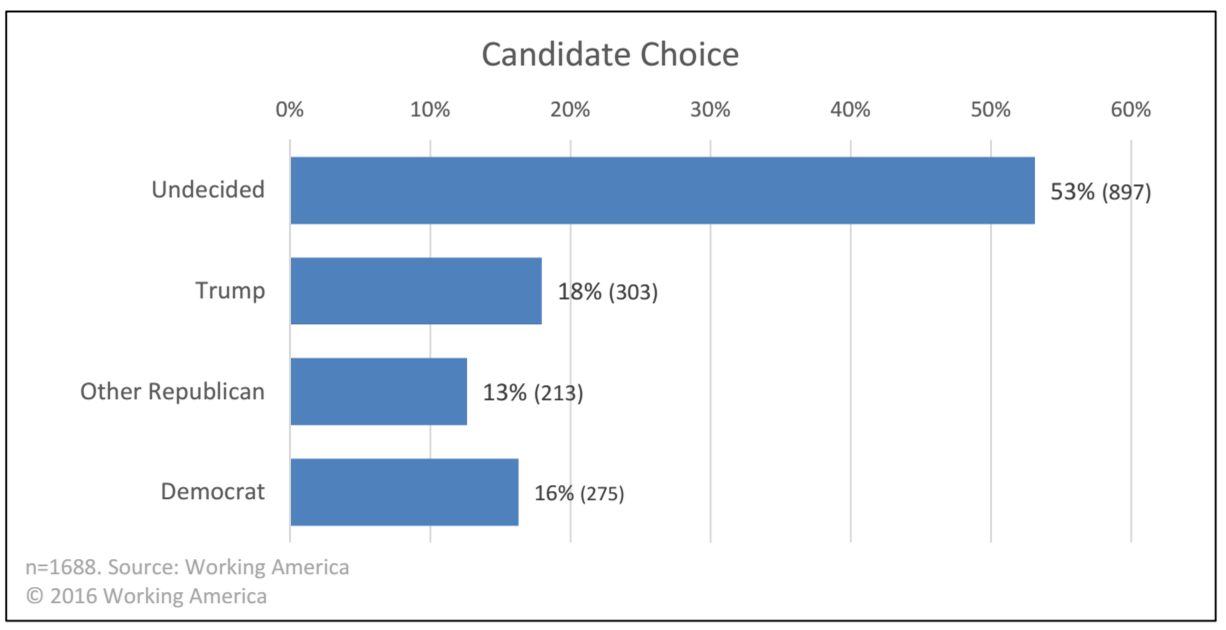
Among those Democrats who chose a candidate, Trump was the top choice for a quarter of them. However, some in this group switched back and had a Democrat as their second choice. One man from Ohio liked Trump, but his second choice is “that old guy, Sanders.” Another voter said, “if not Trump, then Hillary.”
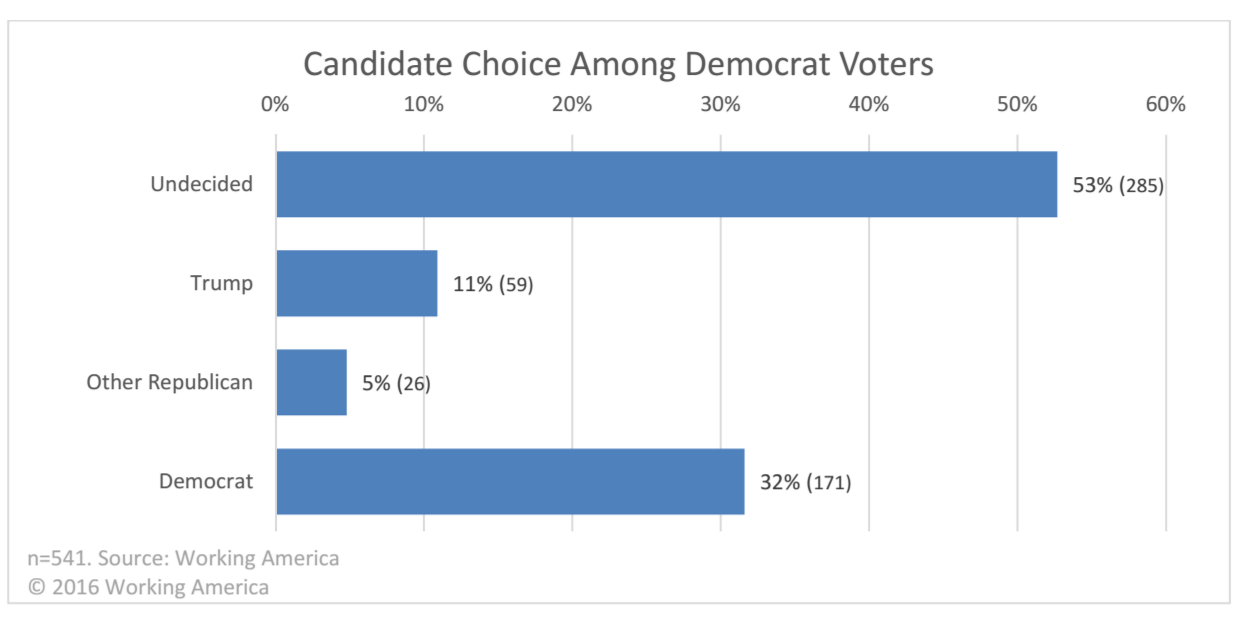
Canvass organizers were struck by the level of emotion expressed by voters, both in describing their own circumstances and stresses, and in their feelings about some of the candidates, especially among those who ardently supported Trump. One-third of Trump’s supporters said they weren’t considering anyone but him.
But there were also voters like the man from Medina, Ohio, who said, “Trump is a clown,” and the woman from Brunswick who said, “Trump scares the willies out of me!”
Of the 53% of voters who were undecided, about equal proportions lean Republican, Democrat, and Independent.
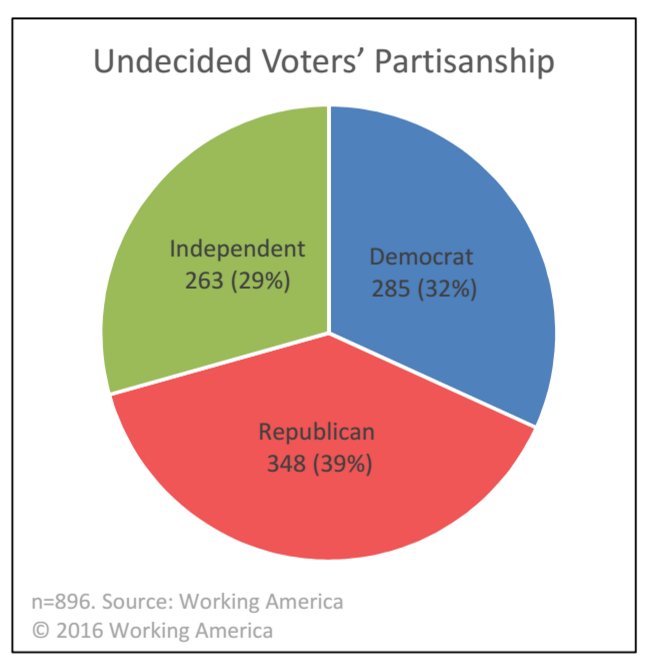
IT’S STILL THE ECONOMY FIRST
Over our 13 years of engagement at the doors, Working America members consistently identifygood jobs and health care as their top two issues – across all geographic regions, demographic breakdowns and party affiliations. Even among our Republican members, good jobs get top ranking.
In this front porch focus group, good jobs and the economy was still the top issue, with 27% of voters identifying this as their lead concern.
However, two months after the Paris terror attacks, and facing a continued stream of ISIS media attention, homeland security and terrorismwere also on their minds, prioritized by 14%. That concern fueled some of the interest in Trump; as one Ohioan told us, “Trump runs a business and can hold the presidential position. It’s all about power.”
Health care remained important to voters, with 10% citing it as their top issue. Other concerns included immigration, retirement security and personal debt.
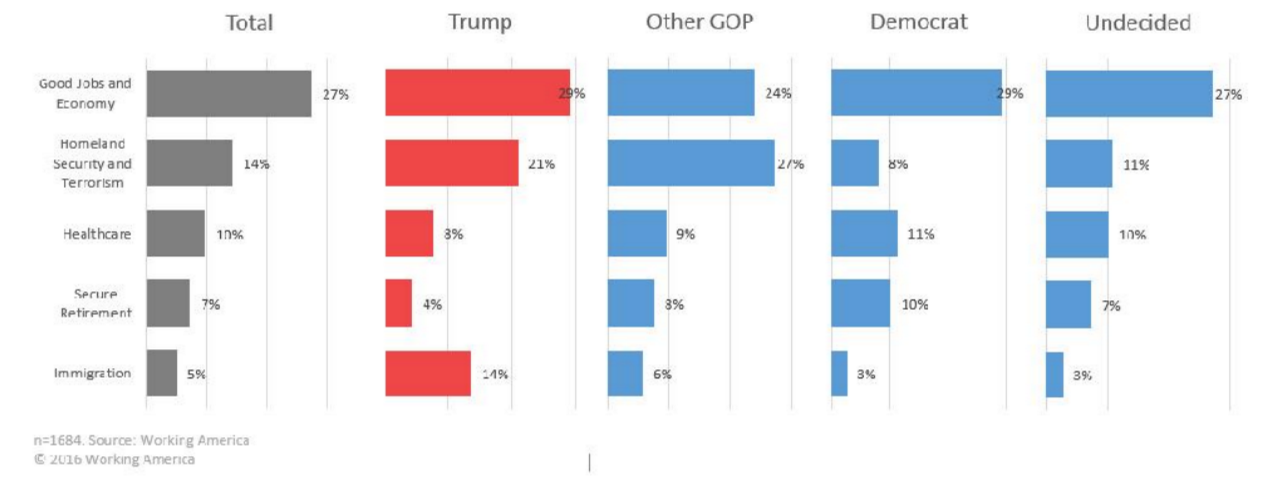
Only 5% of the voters we canvassed cited immigration as their first priority, but 48% of those who chose immigration as their top issue supported Trump.
HE SPEAKS HIS MIND
So, what do people like about Trump? When it came down to a question of personality vs. policy, Trump’s attitude was the dominant factor. Nearly half of voters who identified themselves as supporters volunteered that they like him because “he speaks his mind.” Four times as many voters responded that way than “I agree with his policies.”
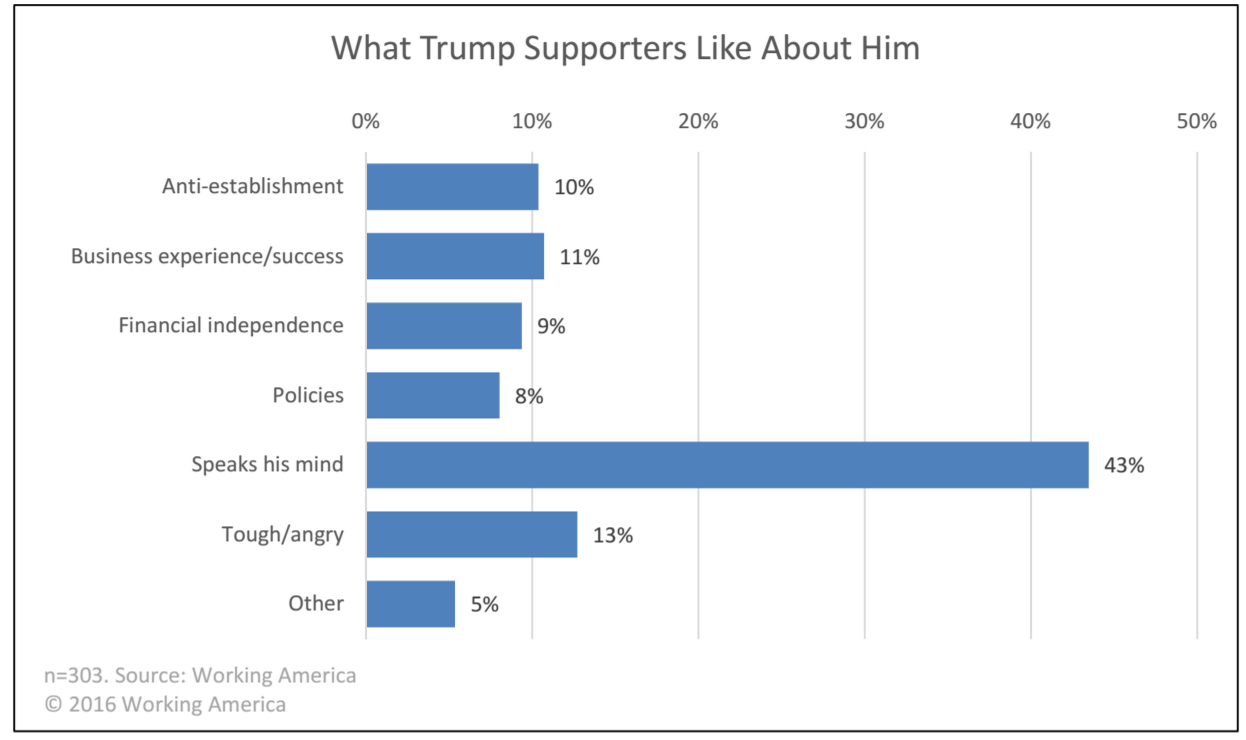
However, even among those declaring for Trump, there were distinct and disparate categories of support, including:
Two-thirds of Trump supporters would consider a second choice, but those choices were across a wide spectrum of candidates. Among those who would consider a second choice, nearly half of all Trump supporters had other Republican candidates in mind, while 16% said they would pick someone else if he were not the nominee but were undecided. Only 4% of Trump supporters said they were considering a Democrat as a second choice.
A Wadsworth, Ohio, voter, for example, likes what Trump has to say, but didn’t seem decided, adding that he liked some of what both Republicans and Democrats have to offer. He identified as an Independent and admitted he is “a little overwhelmed by all the choices.”
“Believe it or not – I can’t believe I’m saying this – Trump,” a woman in Medina, Ohio, confessed. She usually votes Democrat but is sick of what’s been happening the past few years. She knows Trump is brash, but at least he speaks his mind. Clinton is her second choice. Another woman from Pennsylvania who picked Trump actually prefaced it with “I hate to say it, but Trump.” When asked why, she said, “He says what most of us are thinking.”
CHANGING THE CONVERSATION
The fact that Trump evokes a strong emotional reaction cuts both ways. On the one hand, it solidifies support from his most ardent fans. But it also provides an opening for questions.
Over the course of longer conversations, some doubts surfaced. In many of these conversations, the disparity between what Trump says and what he actually does, gave voters pause, and opened the way to more nuanced conversations about the issues at stake.
An Ohioan who said his biggest issue was the economy and that he liked Trump’s business experience was less enthused when he considered Trump’s bankruptcies and his tax plan that favors the wealthy and corporations. A woman who said foreign policy was her biggest concern and that she was considering Trump, also felt that, “if you go to a leader of a nation and talk crazy, we will be at war in five minutes.”
In regard to immigrants and Muslims, some voters voiced racist sentiments and hardline positions. “Trump is the only one to mention immigration,” said a man from Brunswick, Ohio. He continued, “I’m so angry about the situation. I’m OK with shipping them all out and make them come back the right way.”
Feelings about Muslims were often coded as immigration and terrorism concerns, as with a woman in Medina, Ohio, who said she liked Trump because it’s important to screen all immigrants. “People better get a darn good check-up before they allow them to come here.”
However, other voters used the conversations with canvassers to reflect on their initial response and dig deeper. A voter for whom immigration was the paramount issue was uneasy when he considered Trump’s use of undocumented workers on some of his own development projects.
And there were those like the constituent from Wadsworth, Ohio, who expressed concern that Trump’s anti-Muslim remarks wouldn’t serve the country and he could “start a war with his mouth.”
In assessing the interactions on these issues over the five weeks, canvassers considered the conversations some of the most promising indicators that right-wing hate speech can be successfully countered by good information and time to consider positions with a trusted messenger.
While Trump’s rise in popularity and the persisting appeal of his message was the impetus, this field test set out to better understand the attitudes and assumptions behind the support for Donald Trump specifically, and the rise of right-wing populism broadly.
While our findings are preliminary, a few critical insights are emerging:
Worry is more prevalent than bigotry in determining voter choices. Historically, about one-third of the people we encounter on the canvass are ideologically right-leaning – and this test was no different. Among these voters, attacks on immigrants; on African-Americans, including President Obama; and on Muslims resonate, and hold sway.
However, a far greater number of prospective voters are more deeply concerned about the economy and about their fates, and the future of their families, in a time of rapid change. When a conversation about the issues comes to the fore, many are willing to hear new information. This ability to connect with more and better information, and to gain a different perspective on the systemic reasons for economic, political and social inequality, is a major antidote to the dog-whistle politics of bigotry.
The frustration with politics is pervasive. White working-class voters often feel powerless to change a government that they do not see as respecting their concerns or serving their needs. They want things to be different but despair that they ever will be.
Working America, as an ongoing organization, credibly broadens the discussion from elections to political accountability. We talked to voters not just about their vote choice but the importance of holding elected officials accountable after the election, and we found this useful in addressing voter frustration.
The medium is central to the message: Face-to-face conversations are critical for breaking through reflex thinking on difficult issues. Working-class voters are hungry for an independent voice to deliver clear information and with whom they can discuss the issues. Many who said Trump appealed to them because he “speaks his mind” didn’t see a way forward other than through the firestorm of Trump’s rhetoric. For some, however, our engagement – a combination of validation and information – gave them pause.
Above all, we discovered that a surprising number of people were eager to engage in the conversation, sometimes for an extended length of time, and that they were looking for insights they considered reliable and for a way forward to remedy the uncertainty they feel about their lives and the future of the country. Without a countervailing pull of authentic engagement about issues and a progressive vision for the future of the country, the appeal of right-wing rhetoric will continue.
We use cookies and other tracking technologies on our website. Examples of uses are to enable to improve your browsing experience on our website and show you content that is relevant to you.